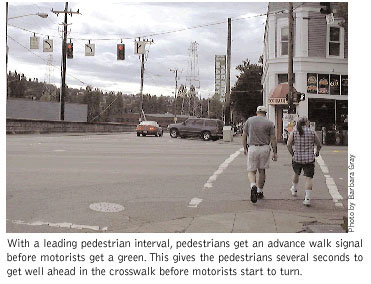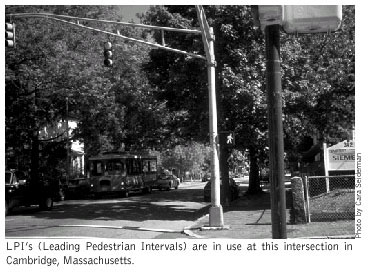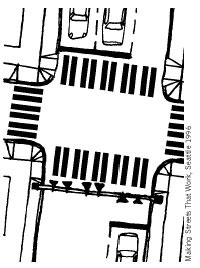41. Upgrade/Modify Pedestrian Signal Timing
Shorter cycle lengths and longer WALK intervals generally provide better service to pedestrians and encourage better signal compliance. For optimal pedestrian service, fixed-time signal operation usually works best. Pedestrian push buttons may be installed at locations where pedestrians are expected intermittently. Quick response to the button or feedback to the pedestrian should be programmed into the system. When used, push buttons should be well signed and fully accessible to pedestrians in wheel-chairs. They should be conveniently placed in the area where pedestrians wait to cross. Since pedestrian push-button devices are not activated by about one-half of pedestrians (even fewer activate them where there are sufficient motor vehicle gaps), new "intelligent" microwave or infrared pedestrian detectors are now being installed and tested in some U.S. cities. These automatically activate the red traffic and walk signal when pedestrians are detected. Other detectors can be used to extend the crossing time for slower moving pedestrians in the crosswalk.
In addition to concurrent pedestrian signal timing (where motorists may turn left or right across pedestrians' paths), exclusive pedestrian intervals stop traffic in all directions. This timing has been shown to reduce pedestrian crashes by 50% in downtown locations with heavy pedestrian volumes and low vehicle speeds and volumes2. With concurrent signals, pedestrians usually have more crossing opportunities and have to wait less. Unless a system is willing to take more time from vehicular phases, pedestrians will often have to wait a long time for an exclusive signal. This is not very pedestrian friendly, and many pedestrians will simply choose to ignore the signal and cross if and when there is a gap in traffic3.
Leading Pedestrian Interval
A simple, useful change
is the "leading pedestrian interval" (LPI). An LPI gives pedestrians
an advance walk signal before the motorists get a green
light,
giving the pedestrian several seconds to start in the crosswalk where
there is a concurrent signal. This makes pedestrians more visible to motorists
and motorists more likely to yield to them. This advance phase approach
has been used successfully in several places, such as New York City, for
two decades and studies have demonstrated reduced conflicts for pedestrians.
The advance phase approach is particularly effective where there is a
two lane turning movement.


There are some situations where an exclusive pedestrian phase will still be preferable. They are desirable where there are high volume turning movements that conflict with the pedestrians crossing.

Purpose:
- Improves pedestrian accommodation at signalized crossings
Consideration:
- Wider intersections may require longer cycle lengths
- Longer walk intervals may also lead to longer cycle lengths.
Estimated Costs:
Adjusting signal timing is very low cost, and requires a few hours of staff time to accomplish. New signal equipment is approximately $20,000.